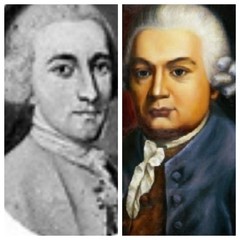|
Back
The Transcendence of Eras New York
Zankel Hall, Carnegie Hall
02/22/2022 -
Baldassare Galuppi: Keyboard Sonata in F minor, I. 9 : 1. Andante spiritoso – Keyboard Sonata in C minor, I. 34 : 1. Larghetto
Wolfgang Amadeus Mozart: Rondos in F major, K. 494, & in D major, K. 485 – Fantasy in D minor, K. 385g [397] – Gigue in G major, K. 574 – Piano Sonatas No.15 in C major, K. 545, & No.14 in C minor, K. 457 – String Quintet No.4 in G minor, K. 516 : 4. Adagio (arr. Olafsson) – Adagio in B minor, K. 540 – Ave verum corpus, K. 618 (arr. Liszt)
Carl Philipp Emanuel Bach: Rondo in D minor, Wq. 61/4, H. 290
Domenico Cimarosa: Keyboard Sonatas No.42 in A minor & No.55 in D minor (arr. Olafsson)
Joseph Haydn: Piano Sonata No.47 in B minor, Hob.XVI.32
Olafsson Víkingur (Pianist)

V. Olafsson
I
Oh Galuppi, Baldassaro, this is very sad to find!/I can hardly misconceive you; it would prove me deaf and blind;/But although I take your meaning, ‘tis with such a heavy mind!
II
Here you come with your old music, and here’s all the good it brings./
What, they lived once thus at Venice where the merchants were the kings./Where Saint Mark’s is, where the Doges used to wed the sea with rings?
VII
What? Those lesser thirds so plaintive, sixths diminished, sigh on sigh/
Told them something? Those suspensions, those solutions—“Must we die?”/Those commiserating sevenths—“Life might last! we can but try”
From A Toccata of Galuppi’s, by Robert Browning (1812-1889)
“I am person of the 18th Century.”
Mezzo-soprano Cecilia Bartoli (1966– )
What? No Hammerklavier? No Chopin Sonata? No Liszt save a Mozart transcription? Víkingur Olafsson, in his New York premiere, was hardly trendy. But never never Liszt-less! In fact, like Browning’s A Toccata of Galuppi’s, Víkingur Olafsson, turned the 18th Century, the Age of Reason, into the Age of Circumspect Passion.
The first time I heard Mr. Olafsson, on YouTube, I imagined that his piano was no longer a percussion instrument. The keys had the sounds of feathers with silvery tones. He could dust off the 32ndnote runs without even pushing them. Yes, he had the emotion, the punch, he proved that his 18th Century “balanced tasteful” composers had complex emotions, startling changes, far less logic than the early Romantics.
Last night at Zankel Hall, he proved that my initial reaction was the right one. And that a critic’s assertion that Mr. Olafsson, was “an Icelandic Glenn Gould” was far off the mark.
His program, yes, was confined to the Venetian/Viennese-style Classical composers, famed and obscure. Most were Urtext, but the pianist had arranged several. Either from the original clavier notes or, one case, from a Mozart Quintet. Yet never did one feel the slightest impression of “transcription.”
Mr. Olafsson requested no applause between works of the two halves. But so mesmerizing were the notes that nobody would have wished to disturb him.
To start with an unfamiliar piece from the Venetian opera-composer Baldassare Galuppi was a minor audacity. Yet this Andante spiritoso was unbelievably beautiful, as was the following modernistic Mozart F Major Rondo. One attempted to ignore the fleet finger work to concentrate on the music, yet Mr. Olafsson ran down the keys with the fluidity of a river stream.
At his next concert, I would hesitate to bring a piano-playing child. That old warhorse, the Mozart C Major Sonata, attempted by every second-year student, would never be played again. So transparent, clear and brilliant were those first-movement runs that one can never dare to imitate them.
I counted ten different works in this first half, including Mr. Olafsson’s reharmonization of a Cimarosa Sonata. Yet each had its own character, from Mozart’s exceptionally difficult Gigue (a tribute to his new discovery of Bach) to the glorious Mozart Fantasia.

C.P.E. Bach/B. Galuppi
This is one of Mozart’s truly passionate, even dramatic short works. Possibly like Schubert unable to finish his Eighth Symphony, Mozart left this unfinished. Mr. Olafsson added a Mozart D Major Rondo. Under other hands, this might have seemed daring. But so gently and feelingly, with breathless tragedy did Mr. Olafsson, play the original that the ending was like letting out one’s breath...to return into our own universe.
The second half had relatively longer works, like Mr. Olafsson’s arrangement of the Larghetto of the K. 516 Quintet. The original is one of Mozart’s most towering late works, and doubtless the transcription was excellent. Still, those who know this work will feel that–even with the shadings, the color, the exactitude of dynamics–it could hardly replicate the original string instruments.
That personal disappointment was assuaged by Mozart’s K. 457 Sonata. Once again, this was technically miraculous. More important, it could have been composed by the Beethoven of the Appassionata, so glorious–and so innate–were the sounds.
I usually pay no attention to encores. But Mr. Olafsson, broke out of Early Classicism for an arrangement by one August Stradel for a Bach Organ Sonata. And this encompassed all the virtues of his earlier work. The organ sounds were transubstantiated into a powerful Steinway, the clarity of Mr. Olafsson’s fingers made every line a transparent line, and he offered to Bach a force which transcended century or era.
Harry Rolnick
|